Little Black Angels
(Angelitos negros)
Not many people know that Andrés Eloy Blanco, one of the most prominent Venezuelan writers of all time, was the author of the poem Angelitos negros, Little Black Angels. The poem became the lyrics of the popular song of the same name, which traversed the borders of Venezuela to re-emerge as an anthem against racism in Latin America. It was in this form that I first heard Angelitos negros, and my favourite version is the one by the Venezuelan singer Soledad Bravo. Please click here to listen to this version.
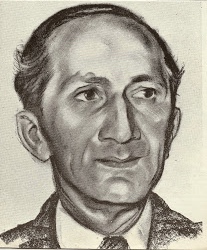
Andrés Eloy Blanco
In my previous article La Copla, I discussed the phenomenon that occurs when a piece of art is somehow appropriated by its people. Similarly, Angelitos negros [1], transcended its creator’s vision to become part of Latin American folklore.
It is said, that Andrés Eloy Blanco [2] may have been inspired by a painting located in the Macarena Basilica, in Seville. The image of the Virgen de Coromoto. Comoroto’s Virgin, Venezuela’s patron, is surrounded by angels, however there are no black angels depicted within this heavenly host.
The poem Angelitos negros starts off by describing the profound sadness of Juana, a woman of African origin, whose little son has died. The second verse is very significant as it describes the mother and her son, “consuming themselves”, suggesting that both are malnourished:
Como ella se consumía,
lo medía con su cuerpo.
Se le iba poniendo flaco
como ella se iba poniendo.
— & —
As she consumed herself,
She measured him against her body.
He was becoming as thin
As she was. [Free translation]
Juana, in the midst of the devastating pain at the loss of her son, hopes that he will be with God. A little angel in the sky, she says. The narrator of the poem counters Juana’s fervent wish; Disabuse my friend, there are no black angels.

It is, lets say, more often than not that white angels surround the Virgin in any painting.
The poet directly addresses the artists of his homeland, these painters of saints and Virgins, reproaching them that they do not paint black angels; and in failing to do so they had denied their own kind. The poem eloquently asks for equality:
No hay pintor que pintara
angelitos de mi pueblo.
Yo quiero angelitos blancos
con angelitos morenos.
There is no painter to paint
angels of my people.
I want white angels
with dark angels. [Free translation]
Andrés Eloy Blanco (1896 – 1955) wrote this poem at a time when issues of racial discrimination were not on the top of the Venezuelan political agenda. His honest views of the world gave voice against the racial discrimination perpetuated in religious art. This was, in many ways, a milestone even in the decades that followed. He remarks in the poem:
no hay una iglesia de pueblo,
donde hayan dejado entrar
al cuadro angelitos negros.
— & —
there isn’t a village church,
where they have allowed
black angels to be painted. [Free translation]
Andres Eloy Blanco is considered to be one of the most talented Latin American poets whilst simultaneously being an adept lawyer and politician. His polemical discourse portrays his concerns about his country and world affairs, which ultimately led him into exile.
Francisco Camacho, Venezuelan university professor, stated that Andres Eloy Blanco lent his poetic talent to those who had no voice and that they could see themselves reflected in his verses [3]. Some political and literary commentators compare this song with the speech of Martin Luther King I have a dream. Andrés Eloy Blanco always condemned intellectual opportunism and had an uncompromising view of the world where ethics should not be negotiable.
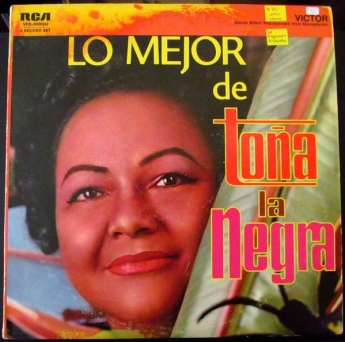
Cover of The best of Toña “La Negra”.
The Mexican singer Toña “La Negra” (1912 -1982) was the first to interpret the song Angelitos negros, followed by the Mexican actor and singer Pedro Infante (1917-1957). In order to listen to the version of Toña “La Negra” please click here and for the version of Pedro Infante in the 1946 film Angelitos negros, please click here.
The version sung by Antonio Machín (1903-1977), a Cuban singer, is considered by many to be the best version and it has retained its popularity to this day. However, many other very interesting versions have been recorded over the years keeping this song alive. Please click here for the version of Antonio Machín with the lyrics in Spanish.
Spanish, like the English language, has had a global impact due to its history of proactive colonisation. The power of a word is such that a language mirrors and transmits cultural and moral values of a society, reinforcing them. Angelitos negros is a good example where the model of exclusion is applied in religious art.

Pedro Infante in the 1948 film Angelitos negros.
In 1492, the Spanish Empire began their process of expansion, known as “colonization”. In Latin America the Spanish Empire established a model of exclusion of African and indigenous peoples based upon a racial hierarchy, which still prevails to this day. The use of words such as mulatto (mulato in Spanish), mestizo (mestizo in Spanish) and black (negro) have been part of a large jargon of words which stigmatize, to economically exclude these social ethnic groups.
This “concept of races” and racial stratification perpetuated economical exclusion and has brought devastating consequences to the indigenous and black communities in Latin America to this day.
Angelitos negros gives us another great opportunity to explore different variations of a song to discover which of the many versions is our favourite one. I would like to invite you to surf on YouTube and find your favourite version. Have you found one that you would like to share with us? Please add it below with your comments.
January 2016
Footnotes
[1] For an electronic copy of the poem Angelitos negros in Spanish, please click here.
[2] For further information on the life and works of Andrés Eloy Blanco, please click here to a pdf in Spanish of his biography: Andrés Eloy Blanco y la posteridad, Andrés Eloy Blanco and Posterity, by Oscar Sambrano Urdaneta, Universidad Nacional Abierta.
[3] Free translation from: Prestó su talento el poeta para que los que no tenían voz se vieran reflejados en sus versos. Fragment from Andrés Eloy Blanco: periodismo, modernidad, y política en la Venezuela de la primera mitad del siglo XX, page 22, Profesor Francisco Camacho, Instituto Universitario Experimental de Tecnología Andrés Eloy Blanco. Barquisimeto, Universitary Experimental Institute of Technology Andrés Eloy Blanco, Venezuela.
The Son of the Bride and Tiramisu
(El hijo de la novia y Tiramisú)
I have a terribly sweet tooth and one of my favourite deserts is Tiramisu, of which I have a few humorous anecdotes to tell, but not here, unless of course you ask. Surprisingly, the 2001 Argentinean comedy-drama film, El hijo de la novia, The Son of the Bride, springs to mind, a cinematic masterpiece directed by Juan José Campanella [1]. But, why a desert of Italian origin should be discussed in a blog about Spanish language and culture, should come as no surprise, to those of you who follow my blogs. We will look at this later.

The Son of the Bride is a homage to the fragility of human dreams and pursuits. An ode to the ephemeral nature of life, which at times needs to be sweetened, as in the film, with a taste of Tiramisu.
The Hijo de la novia, brings together an exceptional cast of Argentinean actors and actresses and it is mainly two stories that run parallel paths. In the film, the Belvedere family reveal the loves of two different generations: Rafael played by Ricardo Darín and Naty, Rafael’s girlfriend (Natalia Verbeke); Nino, his father (Héctor Alterio) and his mother Norma (Norma Aleandro). The narrative of the film develops the idea of love confronting the vulnerability of life, its fragility and its endurance.
Nino is genuinely in love with Norma after 40 years together. He is burdened by the guilt that he did not fulfill, in his youth, Norma’s wish of marrying in a church and he wants to make amends. However, Norma suffers with Alzheimer’s, and is not aware of Nino’s scheme to put things right. Norma still appears to know those who she always loved. The remarkable performance of the actress, Norma Aleandro, gave me goosebumps and left me with a lump in my throat.

Norma Aleandro, Argentinean icon, film and television actress, who starred in many award winning films.
In the context of Argentina’s perennial economic woes, Rafael runs a restaurant and faces the struggle of a man’s midlife crisis, including his relationship with his girlfriend Naty. She feels excluded because he puts his own self limitations and selfishness before love. Will he find what is true and meaningful in his life?

Natalia Verbeke, Argentinean-Spanish film, theatre and television actress in her great performance as Naty, in The Son of the Bride.
This is a film that crosses the boundaries of love stories and explores the contradictions of the Catholic Church. When the priest refuses to marry his parents on the grounds of ill health, Rafael takes the opportunity to show the priest how detached the Church is from the real world. It is over these sequences of events that Rafael begins to discover what is essential in his life.
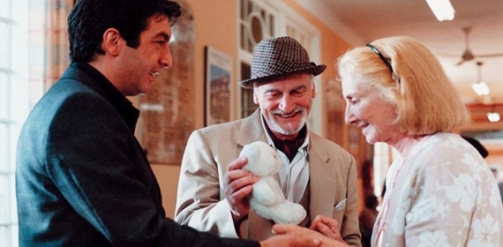
El hijo de la novia develops gently in so many layers, as with the layers of Tiramisu; and although during the film the whole recipe is not revealed, we are given a clue as to its key component: mascarpone cheese.
Hoy compramos mascarpone. El especial del día, Tiramisú Norma.
“Today we buy mascarpone. The daily special, Tiramisu Norma”; Rafael instructs Pacheco, the cook in his restaurant, making the point that a Tiramisu cannot be made with any cream cheese, even during the financial crisis that the whole country is going through.

In El hijo de la novia there are images and silent scenes that say more than a thousand words. There are also eloquent dialogues that stayed with me long after the film finished. I hope these dialogues will impact upon Spanish students and trigger a further debate (in Spanish of course).
Italian in origin, Tiramisu has become part of Latin American and particularly Argentinean Cuisine. In the absence of a Tiramisu recipe in the film, I would like to share the delicious Tiramisu recipe from my family, a super-dooper delicious one, from my beloved auntie and godmother Celia. The recipe will be available in my next blog.
¡Hasta la próxima!
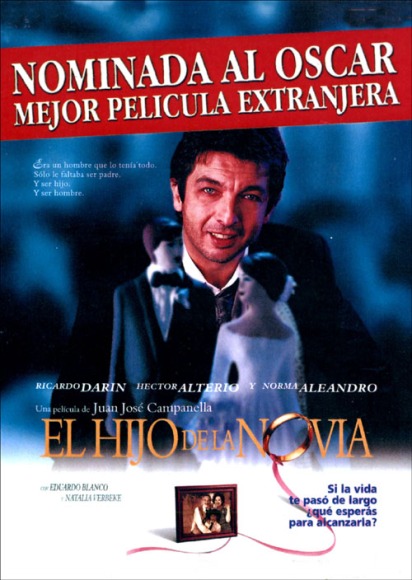 Footnotes
Footnotes
[1] A copy of the complete film El hijo de la novia in Spanish without subtitles can be found in YouTube, please click here.
A copy of a DVD of The son of the bride, with English subtitles, can be obtained from Amazon.es
… …
This article is part of the series: Recipes from the big screen. See Spanish and Latin American Cuisine (Part1) – Recetas de películas; and Recipes from the big screen. See Spanish and Latin American Cuisine (Part2) A Recipe for Almond Cake. Why is This Recipe so Special?
The Things of Love
(Las cosas del querer)
Following my previous article, Ojos Verdes, Green Eyes, I received requests to share some thoughts on the beautiful copla, Las cosas del querer, The Things of Love, as well as the 1989 film of the same name. In honour of this here are my musings. For a moment of pure pleasure, listen to Las cosas del querer sung, in Spanish, by Angela Molina and Manuel Banderas: please click here. Do return as there is more to come.
See below the chorus translation:
Son las cosas de la vida,
son las cosas del querer,
no tienen fin ni principio,
ni tien(en) [1] cómo ni por qué.
Tú eres alto y yo bajita,
tú eres rubio y yo tostá;
tú de Sevilla la llana
y yo de Puerto Real.
Que no tiene na’ [2] que ver
ni el color ni la estatura
con las cosas del querer.
Lo nuestro tiene que ser
aunque entre el uno y el otro
levanten una pared.
— —
These are the things of life,
these are the things of love,
they don’t have an end nor beginning,
they don’t have a how nor a why.
You’re tall and I am short,
you’re blond and I am brown;
you’ re from the Sevilla plains
and I’m from Puerto Real.
These have nothing to do,
colour or height,
with the things of love.
Our love is meant to be
even if between us
they build a wall.[3]
The passion conveyed, by these great Spanish voices, through the coplas have always delighted audiences with their heartfelt lyrics and these still resonate to this day and stir my emotions.
Las cosas del querer, The Things of Love, is a copla, which became renowned during the unsettled times of 30’s and 40’s Spain. Composed by Rafael de León and Antonio Quintero, possibly the greatest copla composers of all time, and sung by, amongst others, Miguel de Molina. The lyrics convey the universal message of the unconditional nature of love.
The legendary life of singer Miguel Molina is unveiled in his autobiography Botín de guerra, Spoils of War, and its similarities with the plot of the 1989 film Las cosas del querer led many to believe that the film was inspired by his life [4].
Written and directed by Jaime Chávarri the film is a celebrated piece of Spanish musical cinema. It became so successful in Spain and Latin America that a sequel was filmed in 1995.
Anticipating an abrupt departure brought about by the forced exile of the main character Mario, the film begins by framing the plume of a steam-train and its boarding whistle call. Mario, portrayed by Manuel Banderas, is standing in the carriage with a bruise on his face. Mario’s voiceover sets the tone that follows:
“We never will see each other again, the three of us know that. I can no longer live in this damned country and I am not only leaving because I’m cast away but also because I do not know what to do with my life and with you.
We’ve been so together these years, the three of us. Juan: you and me, we met before. We lost the war in the same regiment and that afternoon the bombing near the hospital changed our lives.” [5]
Then, as if Mario were looking at the past through a mirror, the story begins to be told. The Spanish Civil War is coming to an end and as a game of fate Mario, Pepita and Juan are reunited again.

Manuel Banderas, as Mario, Ángel de Andrés López, as Juan and Ángela Molina, as Pepita in the film Las cosas del querer.
The story is wonderfully narrated and intertwined with songs such as: La bien pagá, She, The Well Paid; Compuesta y sin novio, Composed and Without Boyfriend; Te lo juro yo, I Swear; and many of the best known songs of this time.
Mario’s story has a strong resemblance to the life of Miguel de Molina. Together with Manuel Banderas, two other great Spanish stars: Ángela Molina (Pepita) and Ángel de Andrés López (Juan) tell the story of three artists that join together as a musical group. Mario, gay and a Republican, is in love with Juan whereas Juan is in love with Pepita; and whilst Pepita is in love with Juan, she faces the same equality issues that the women of today face in striving for an independent career.
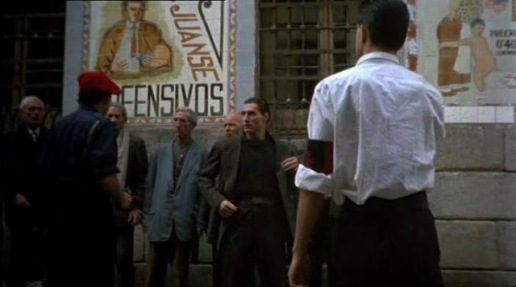 The three confront the post Spanish Civil War times encountering throughout the prejudice of a conservative society that will lead to Mario’s exile.
The three confront the post Spanish Civil War times encountering throughout the prejudice of a conservative society that will lead to Mario’s exile.
Often we forget important moments from our past: I am talking about the histories of those who inhabited our homes a few generations ago and perhaps what Las cosas del querer does best, is to bring to mind the memories of a not very remote past that we should not forget … and of Miguel de Molina of whom someone has said: He could be blamed for being the most arrogant and handsome, and in the contours of Sierra Morena, there was no one more beautiful, kinder or honest [6].
The complete film is available on YouTube, to see the film Las cosas del querer, only in Spanish without subtitles, please click here.
August 2015
— —
Footnotes:
[1] tien: tienen
[2] na’: nada
[3] Free translation.
[4] At the beginning of the film credits, thanks are given to Quintero, León, Quiroga, Mostazo y Solano and many other authors that made the Andalusian song /Canción Andaluza. At the end of the film we are warned that any similarities with reality would have been pure coincidence.
There has been some controversy as to whose life may have inspired the film Las cosas del querer. Some have stated that the character Mario was bluntly inspired by the endearing life of the legendary Molina. Miguel de Molina himself expressed in his autobiography Botín de guerra, Spoils of War, his devastation because he did not receive a penny of copyright revenue that he understood belonged to him.
[5] Free translation from: Ya nunca volveremo(s) a verno(s), lo sabemo(s) los tre(s). Yo ya no puedo vivir en este jodido paí(s) y no me voy solo porque me echan, me voy también porque no sé que hace(r) con mi vida y con vosotro(s).
Hemos estado tan junto(s) esto(s) año(s) los tres. Tú y yo Juan nos conocimo(s) antes. Perdimo(s) la guerra en el mismo regimiento y aquella tarde el bombardeo cerca del hospital cambió nuestras vidas.
[6] Free translation from: Antonio Vargas Heredia, podría achacarse aquello de que era él más arrogante y el mejor plantao, y por los contornos de Sierra Morena, no lo hubo más guapo, más bueno ni honrao.
NEWS: 25th London Latin American Film Festival
Here’s an important message to all you film makers out there.
The 25th London Latin American Film Festival will be held between 13th and 22nd November, this year. The Curator of the festival, Eva Tarr is now inviting submissions to be considered for showing at the Festival.
Just think of it, an opportunity to have your film presented and shown at this important and influential Festival. For 25 years the Festival, with its rich and diverse range of films has thrown an artistic beacon on the vibrancy of Latin American cinema and you and your film could be part of that showcase.
If you would like your film to be considered, please go to the Submissions Webpage at their website click here
For more information and regular updates on activities, there is also a Facebook page you can click here
May 2015
For a previous article on the Latin American Film Festival in London: The 24th Latin American Film Festival, 18 November 2014, click here
A Recipe for Almond Cake. Why is This Recipe so Special?
A delicious recipe from the film Sugar Times. Recipes from the big screen – Spanish and Latin American Cuisine (Part 2).
A tempting recipe for an Almond Cake is beautifully described at the beginning of the film Tiempos de azúcar, Sugar Times, a 2001 Spanish film directed by Juan Luís Iborra. Following a Spanish recipe is another opportunity to use the Spanish language in your everyday life; and why not learn Spanish whilst cooking?
The film begins with Miguel, a 7 year-old boy, writing in a book, nestled in the cosy setting of the family patisserie the “Horno de l’ Alteana“; his pregnant mother Isabel is tenderly dictating to him an old family recipe for an Almond Cake.
The scene captures the extraordinary poetry and tension of the moment. I asked myself: Is she worrying about the possible outcome of the pregnancy? Is this why she is choosing to impart the secret recipe to her son at that very moment, in the event she will not have the opportunity in the future?
She warns him to keep the recipe safe. “It is an old and very special recipe. My mother passed it to me before she died”. Further to this, she asks him for help in that way that mothers do when a choice is offered which is no choice. She states that when the baby comes, she will need his help in the patisserie, as they are on their own.

The curious little boy asks his mum in a quiet voice, “Why is this recipe so special?”
“Once upon a time”, she answers, “a Moorish bondmaid won the love of her Sultan, even though everybody thought her love was an impossible one. She created the recipe for this “Almond Cake” for the Sultan so lovingly; and the cake was so delicious, that in the end the Sultan made her his favorite wife [1].
This recipe is to be kept secret, Isabel warns again. Then, she starts to dictate to him the recipe:
“Se baten doce claras a punto de nieve. Cuando ya están bien duritas, se le echan las yemas. Luego se añade medio kilo de azúcar, (azúcar con la z, Miguel) poco a poco, sin dejar de batir, hasta que se deshaga. Luego se mezclan cien gramos de harina de almidón con cuatrocientos gramos de almendra molida. Se bate todo bien y se le echa la ralladura de un limón, y luego una hora de horno fuerte.
… …
“Beat twelve egg whites until stiff. When they are firm, add in the yolks and slowly pour in half a kilo of sugar (azúcar with z, Miguel), stirring constantly, until it dissolves. Then mix in one hundred grams of corn flour with four hundred grams of ground almonds. Beat all the ingredients well, with the zest of one lemon, and then put in a hot oven for an hour. [2]”
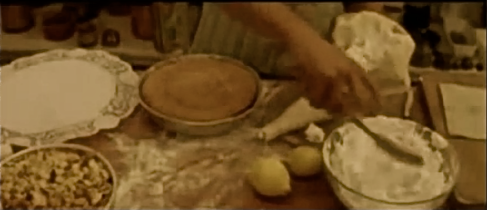
The two letter particle “se” could be of some concern to students learning Spanish, particularly when studying on their own. The particle “se” appears often in the Spanish language, and it has several meanings (himself, herself or itself) as well as different uses.
In this case, the use of “se” is known as “impersonal” and plays no syntactic function. The verb is in the third person and refers to a participant with ‘human’ and ‘undefine’ traits. [3]
Here there is a link to the first few minutes of the film (The recipe is given at 0.37 minutes, in Spanish): click here.

The complete film can be found on YouTube, only available in Spanish. An English subtitled version is available to buy on the internet. Set in Alicante, Spain, Tiempos de azúcar unpretentiously explores those simple things that make life worth living and raises the question: ¿Does life gives us a second opportunity? Juan Luis Borra has the great sensibility to capture significant vignettes throughout the film.

The magical opening of Tiempos de azúcar introduces us to the story of Miguel from childhood to youth and his two passions: his profession as a baker and the platonic love he feels for his lifetime good friend Angela, to whom he is unable to confess his love … until, that is, he decides to bake for her that legendary Almond Cake.
Now, I am not going to do as my naughty father used to do, when the family were watching a film that he had seen before, and he gave away the ending … What happens to Miguel and Angela? I am not going to tell you.
But … does life gives them a second chance?  Footnotes:
Footnotes:
[1] Free translation.
[2] Free translation.
[3] Se: It is a personal pronoun of the 3rd person, singular or plural, masculine and feminine (herself, himself and itself). It is used to construct impersonal sentences, eg.: se pelan las zanahorias, “peel the carrots”; amongst other uses.
This article is part of the series: Recipes from the big screen. See Spanish and Latin American Cuisine (Part1)
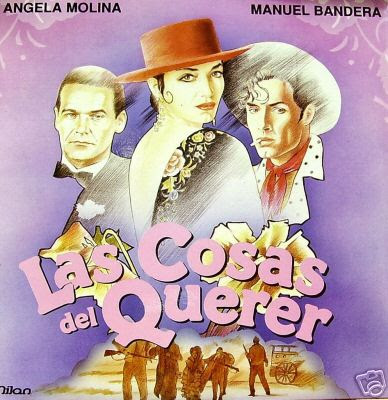
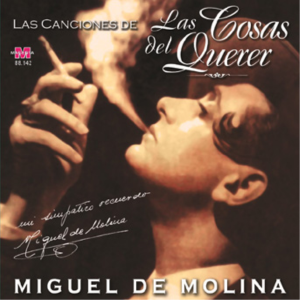





You must be logged in to post a comment.